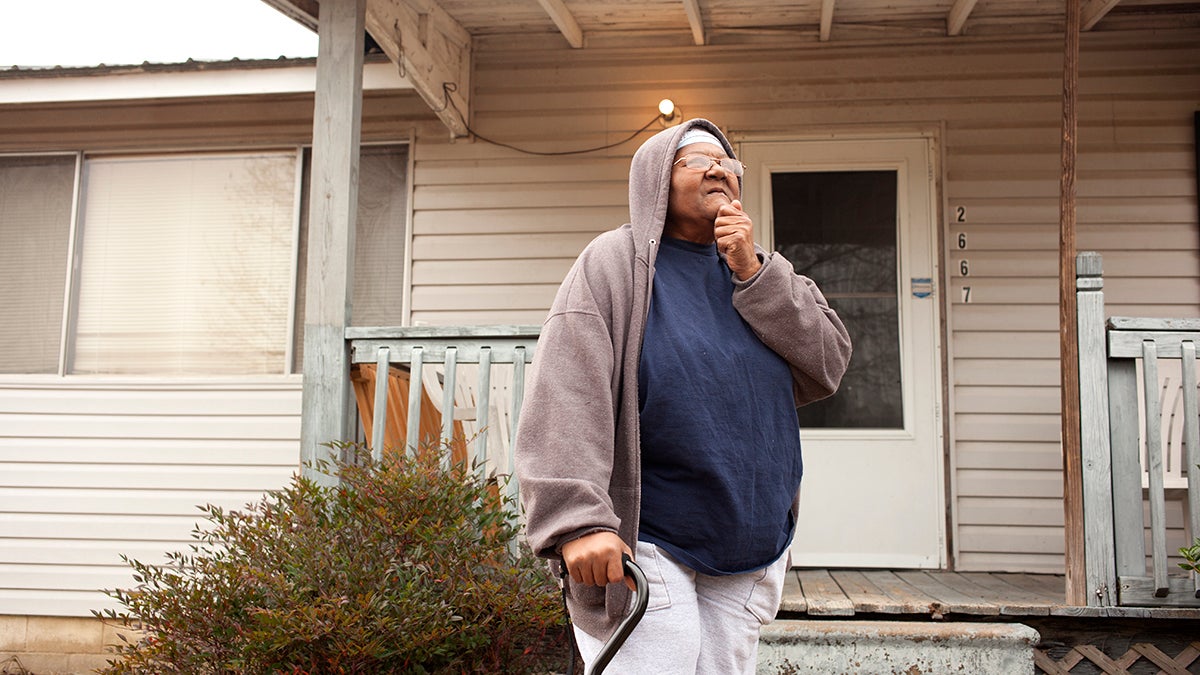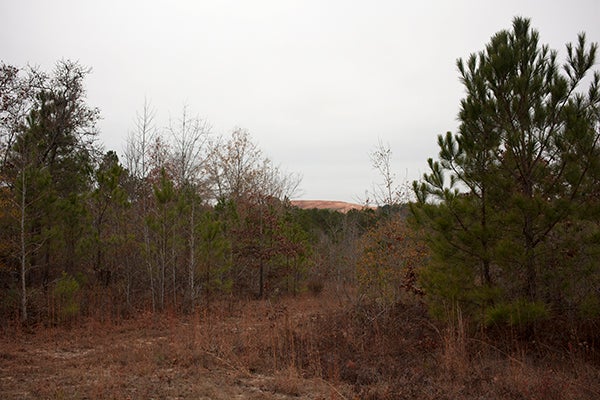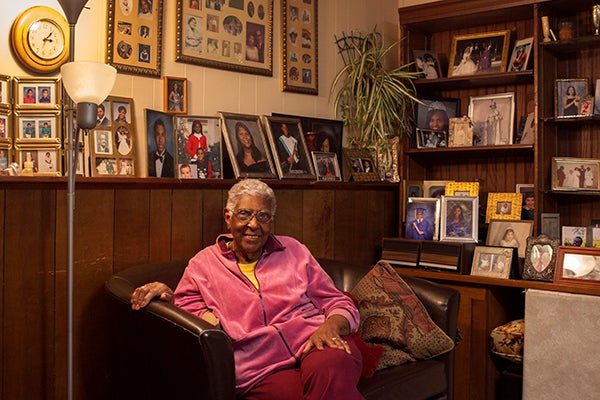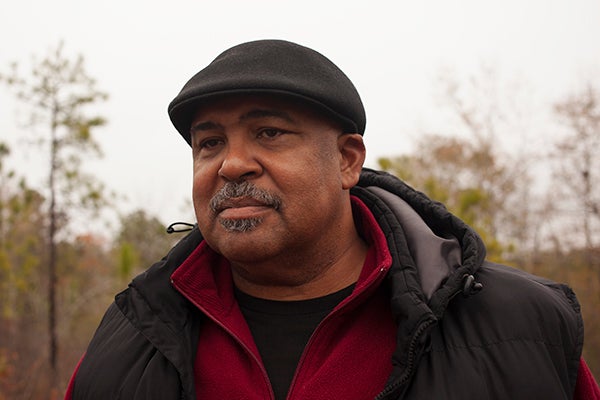In one Alabama community, environmental justice is hard to find

Annie Keller in front of her house in Ashurst Bar/Smith, Alabama. Keller said she's scared of what the landfill is doing to the environment and she no longer sits on her porch because of the smell from the dump. (Irina Zhorov)
A group of African-American landowners filed a civil rights complaint over a landfill. It took EPA more than a decade to quietly close the case.
Annie Keller has lived in Ashurst Bar/Smith, a rural community in Tallapoosa County, in central Alabama, for 65 years. Red dirt colors the landscape beyond the rolling blacktop, and forest mutes out modern day commotion. But in the last few decades the place has changed on her.
“I love to sit on my porch,” Keller said. “It smells so bad, I can’t.”
Keller says the smell gets worse on warm days, in the summertime.
“So I usually put a mask on my face when I come out to cut grass,” she said. “Man, it’s rough. It’s really rough.”
She used to plant a garden every year, with tomatoes, okra, collard greens, turnips — but she hasn’t done that in over 15 years.
“I’m scared,” she said.
She closed up her well and now uses the municipal water supply. She took her clothesline down.
“I used to hang my clothes on them, old-fashioned. Can’t hang them. The last time I hung them out they stunk so bad I had to wash them twice to get that odor out of them,” she said.
“And I knew then that something was serious. I said, ‘Something is wrong.’ These clothes stank like somebody had thrown them on something dead. I was saying, ‘What is this?’ And a lot of them, I threw them away, especially my sheets.”
While Keller stood in her front yard, neighbors nodded in agreement.
One man mentioned that he’s gotten up some mornings to find vultures sitting all over his house, his mother’s house, the trees. Someone else said giant semi trucks run people off the road.
The culprit of all this trouble? Keller leaned on her cane, lifted her hand up, and pointed her finger eastward.
“Go to the end of this road and make a left, and there it is,” she said. “Might be a mile.”
The dump
Down that road is the Stone’s Throw Landfill — a municipal solid waste disposal site. A dump.
When I went to see it, I drove past a pond of muddy water and heavy machinery moving up a mountain of ruddy soil. In this tiny bucolic settlement tucked into forestland, it’s shocking to see. From some vantage points, the hump of dirt, looms through the trees.

I reached out several times to the company that currently owns the dump, Advanced Disposal. The company declined to comment.
The landfill opened in the 1970s. It started out small; at first it only accepted wood cuttings and brush. Over time it grew, then shut down in 1993.
That same year Alabama adopted new regulations to manage landfills. Over time, the number of dumps in the state went from 300 to around 30 today.
The remaining facilities are much larger.
In 1999 the then-owners sought to reopen it as a larger municipal waste disposal site.
It was a two-step process to reopen the landfill. First, the local government had to approve the location, then the Alabama Department of Environmental Management (ADEM), under its new rules, had to issue operating permits.
Because Ashurst Bar/Smith is unincorporated, the location decision fell to the Tallapoosa County Commissioners. They approved the site. After the landfill owners applied to ADEM for the operating permits, people in Ashurst Bar/Smith responded with a letter of protest.
“We … feel our community has been the stepchild of Tallapoosa County for far too long …” the letter says. ”We will not stand by idly and allow our community to be devastated.”
I went to visit the woman who wrote that letter, Ann Smith.
Smith’s house is overflowing with stuff; photos of her family jostle for room on the walls, piles of paper grow precariously from surfaces. Books — so many books — line her generous library. She’s lived in this house, on land gifted to her for her wedding, for more than 60 years.
Smith didn’t want to see the landfill reopen.

“I was concerned about health. And I was also concerned about the value of land,” she said.
The community where the landfill sits is mostly African-American in a mostly white county. It’s a low-income community, but many there have owned their land for generations. Enslaved ancestors acquired property at the first taste of freedom.
Phyllis Gosa, who worked with Smith against the landfill, said she can trace her family to Tallapoosa County starting with the 1870 census.
Owning acres kept the family from being chained to other people’s land, she says.
She added that up to 1960s, many African-American people who didn’t own property ended up working as sharecroppers. “And that was as bad, because you really didn’t have any freedom. You were controlled by your ties to the farm,” Gosa said.
The land carries the weight of heritage as well. “This is where we came from,” she said. “It is important. I can’t trace my history any further than Tallapoosa County.”
Gosa no longer lives in town, but some of her family does. They own about 40 acres, including a 2-acre parcel right in the middle of the landfill, which they refuse to give up.
The environmental agency in Alabama ultimately approved the landfill’s operating permit.
ADEM’s rules are supposed to make landfills safer for people and the environment. The statutes outline technical requirements such as the kind of liners to use and how to properly contain explosive gases.
David Ludder, a lawyer who once worked for ADEM and has been involved with several environmental justice cases in Alabama, says nothing in the statutes prevents dumps from only ending up in poor or minority communities.
It’s something Alabama lawmakers have not tried to address, he says.
“I think that what they believe is that their rules and their permits protect everybody equally,” Ludder said. “But what they’re missing is that they don’t always protect everybody equally. There are many cases where minorities are impacted much more than whites.”

Ron Smith says that is what’s happened in Ashurst Bar/Smith — he’s taken over his mother, Ann’s, fight against the landfill.
“If you look at the map, it’s like our county went through and found out where the black population was and where the black population didn’t stand a chance of fighting, and that’s where they put the landfill,” he said.
Way of life
Ron Smith said the reopened landfill, now bigger, cut the community off from a healthy way of life. The residents used to be intimately connected to the land there.
“The kids used to walk from one house to another through trails in the woods. That was part of the experience of being here. People used to drink out of the springs. That was part of the experience being here,” Ron Smith said.
People in Ashurst Bar/Smith hunted and fished.
“There were three or four pecan trees and then some black walnut trees,” said Bettie Smith, the local school bus driver.
“We didn’t go back home and get anything to eat. We ate what was around us. Sourgrass was there, blackberries, crab apples, and pear trees. We’d go in people’s yards, and they would tell you, ‘Y’all get those pears or whatever.’ And that’s what we ate during the day.”
Now people fear the land. The streams run foul, the air stinks, the trees are dying, residents said.
Bettie Smith doesn’t even buy local produce anymore — she looks for Georgia tags instead of Alabama labels.
She thinks pollution makes local fruits and vegetables unsafe.
“In my mind,” she said. “It may not be, but in my mind.”
No studies have definitively confirmed the presence of pollution, nor the absence of it, in the community.
In 2003, the dump owner applied for a permit to expand. Residents, once again, took to letter writing.
Community members wrote letters against the landfill’s expansion.
“We are opposed because of the adverse effects that it is creating in our neighborhood,” Phyllis Gosa wrote to the district engineer.
Her sister wrote ADEM: “These people have placed their dreams and their lives in the land … This area has sentimental ties for many of us. It binds us with our kindred in a special way that can only be felt, not spoken.”
Another woman wrote, “We have worked hard for our homes. These are acts of terror. No, we don’t want anymore.”
The state’s environmental department — once again — granted the permit to expand.
Long fight
In Ashurst Bar/Smith people say they felt betrayed by the landfill operators, and the local government entities that are supposed to protect them: the Tallapoosa County Commission and the Alabama Department of Environmental Management.
Locals say the landfill owners did not listen to residents’ concerns. When I visited the landfill in hopes of a comment or interview, the current manager aggressively shooed me out of his office, declining to talk.
A lawyer who’s been working with the community, Marianne Engelman-Lado, says landfill employees have acted in intimidating ways in the past. She says in one incident, she and clients stopped to look at the dump from a public road, and landfill workers surrounded and then took video of them.
Neighbors felt the commissioners didn’t care, either. The dump was initially opened to save the county money on waste disposal. The landfill now contributes about a half-million dollars each year to Tallapoosa’s coffers — about 4 percent of the county budget.
Ashurst Bar/Smith bears the burden of the landfill. Locals deal with the stench and heavy traffic, but the landfill income doesn’t stay there — it’s split across the county.
None of the county commissioners live in Ashurst Bar/Smith and residents said they rarely see commissioners come around. George Carleton, the commissioner who represents the district where the landfill is located, did not return calls for comment.
ADEM, the state environmental agency, also would not comment for this story.
But the agency has said its reviews are limited to the technical requirements outlined in state statutes. State agency officials say the local county commission is responsible for making decision on where landfills can be located.
Appealing to the feds
Unhappy with the local response to their concerns, Ashurst Bar/Smith turned to the federal government. In 2003, Phyllis Gosa filed a complaint with the U.S. Environmental Protection Agency, alleging that Alabama’s environmental department discriminated against residents of Ashurst Bar/Smith. They used something called Title VI of the Civil Rights Act of 1964.
The EPA’s requirement to comply with Title VI was outlined in a 1994 presidential memorandum:
In accordance with Title VI of the Civil Rights Act of 1964, each Federal agency shall ensure that all programs or activities receiving Federal financial assistance that affect human health or the environment do not directly, or through contractual or other arrangements, use criteria, methods, or practices that discriminate on the basis of race, color, or national origin.
A major chunk of ADEM’s funding comes from EPA. Under this law, if Alabama is found to have policies that do not protect minority communities, whether intentionally or not, they could theoretically lose that funding.
The EPA accepted Phyllis Gosa’s complaint for investigation in 2005.
The EPA is supposed to investigate and resolve complaints within 180 days. When I started this story, it had already been 14 years since Gosa submitted the grievance to the agency.
“People were very discouraged,” said Marianne Engelman-Lado, a lawyer who’s been working with the community.
And this wasn’t the only complaint that languished in the EPA’s civil rights office. A 2015 investigation by The Center for Public Integrity found that EPA’s work on most complaints, from around the country, did not meet deadlines.
A 2016 report by the United States Commission on Civil Rights found that the “EPA continues to struggle to provide procedural and substantive relief to communities of color impacted by pollution. EPA’s deficiencies have resulted in a lack of substantive results that would improve the lives of people living in already overly-burdened communities. Second, EPA does not take action when faced with environmental justice concerns until forced to do so. When they do act, they make easy choices and outsource any environmental justice responsibilities onto others.”
“EPA has a terrible record of civil right enforcement,” said Engelman-Lado.
“If we thought about any other area of civil rights enforcement and compared it with what we see in the environmental context we just wouldn’t stand for it,” she said.
In 2016 locals upped the ante again.
Earthjustice, where Engelman-Lado worked at the time, filed a lawsuit against the EPA on behalf of five communities around the United States, including Ashurst Bar/Smith. All five had outstanding civil rights complaints. The suit alleged the EPA wasn’t doing its job investigating or enforcing civil rights.
The lawsuit was a bid to resolve the individual complaints, but also to get the EPA to fix its civil rights office, to get it to be more responsive to discrimination grievances.
EPA responds
Even before the lawsuit, the EPA had taken steps to fix its civil rights department. The agency developed a strategic plan, and guidance to state agencies it works with.
After Earthjustice filed the lawsuit last year, the EPA also started closing, one by one, the cases the litigation is built on. In one case, out of Michigan, the agency found the state had unfairly treated a black community in the permitting of a power plant — EPA’s first formal finding of discrimination.
As I was wrapping up my reporting for this story, they closed the Ashurst Bar/Smith case. EPA found there wasn’t enough evidence to say Alabama was unjust to black communities.
Ron Smith and Phyllis Gosa both said they were disappointed but not surprised by the EPA’s findings. “I guess we’ll have to be a Flint before they would take seriously what happened to us,” Gosa said.
Engelman-Lado said the EPA used a narrow technicality to close the case, rather than trying to address an injustice.
The EPA did not respond to repeated requests for comment.
Engelman-Lado says the EPA’s approach caught her team by surprise. She sees the agency’s actions as an attempt to get the litigation dismissed from court.
After issuing its Stone’s Throw Landfill decision, the EPA asked the federal court set to hear the case to toss out the lawsuit. Oral arguments are set for June.
“If you’re disproportionately permitting facilities in a community of color, and the cumulative impact of all these facilities is making people sick or is devaluing their lives or is polluting the water or is devaluing their property or whatever it might be, that is still a violation of the civil rights law,” Engelman-Lado said. “And so EPA from the get-go never developed the culture of enforcing the law.”
Meanwhile, in February, the state renewed the landfill’s permit to operate.
These days, the dump takes in trash from the entire state, and some counties in Georgia. Currently the permitted facility is 175 acres large, with about 130 acres of that permitted for disposal operations. But the company owns nearly 400 acres, so there’s potential for growth.

Bettie Smith, the bus driver, told me she’s the second generation to deal with the landfill.
“You know it’s a losing battle with something so large, and we losing our heritage,” she said. “It’s, to me, it means a lot because this is where I was raised, you know. Fifty-eight years. That’s a long time.”
Smith said she doesn’t know if the next generation, her grown daughters, should continue the fight.
In the past she’s told her daughters, “‘If the Lord he call me on, y’all just bury me and forget about Alabama. Just don’t come back.’ And that’s sad. You know, don’t worry about it. Something happen to me, y’all just go on and say, ‘Alabama was a place that you lived,’ and just go on with your life.”
WHYY is your source for fact-based, in-depth journalism and information. As a nonprofit organization, we rely on financial support from readers like you. Please give today.



